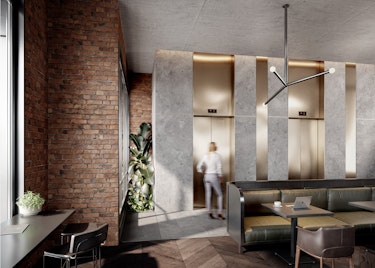Getting a job or an internship at an architecture practice isn't only based on your abilities as an architect or as a student. The way in which you present your capabilities is crucial. Few things are more crucial to an artist's, designer's, or creator's continued success. This is their architectural portfolio - a curated collection of previous work experiences that not only showcases their technical brilliance but also their ability to handle projects of varying scope and scale.
As a result of increased professional competition and the globalization of resumes, putting together a portfolio can seem like a chore and can be time-consuming: Which projects should I include on my list? How should I showcase my personal data? Should my academic works be included in architectural portfolios? Is there anything else you can do to boost your portfolio and secure new contracts?
Most of the time, when a prospective client is looking for new work, all that they go on about is the side-by-side work of a handful artists they might be interested in hiring. You'd better make sure your work is good enough to get them to ring your number, or you might find it hard to find new clients down the road.
The first thing your potential clients will look at is your 3D architectural rendering and visualization. Your portfolio must be powerful enough to convince them and demonstrate that you are a good fit for their project. This article attempts to explain a few things you can do to make your architectural portfolio stand out amid the crowd, as well as why it's so crucial to sell yourself not only on your artistic abilities but also on the tales you tell and the person you are. Your architectural portfolio must help you become noticeable among dozens, if not hundreds, of other job and project applications. The following pointers will assist you in putting together an excellent 3D architectural rendering and visualization portfolio.

Your Personal Narrative
Clients may not realize it, but when they seek 3D architectural rendering or rendering assistance for their projects, they are looking for the person behind the work just as much as they are looking for the work itself. It is quite valuable to present yourself as someone who is not just talented, but also easy to deal with and who completes tasks on time. Personality matters, and it can be difficult to let it come through while using an online, digital architectural visualization portfolio to market oneself as a designer and a person.
This is when the development of your individual website comes into effect. If you haven't invested the time and resources to create a clean, straightforward, and unique online presence, now is the time to do it. This is the best place to incorporate a little whimsical storytelling into your personal brand, and it can help you stand out as an artist. Yes, your architectural visualization portfolio should highlight your artistic ability, but it should also allow clients to interact with you on a more individual basis. Before you even walk in the door, this will help establish trust.
Make a Good First Impression
Even if you only have a few 3D architectural renderings or animations to show off in your portfolio, you should be extremely selective about which ones you show off to the general world. Adopting a quantity over quality approach to your architectural portfolio is the worst method to find a new job. Even if it's something you made in your first year of design school, clients or architecture firms will be put off by substandard work. Get rid of it. Edit your collection as if you were curating your own personal museum.
You will eventually have enough body of work to help fill in whatever gaps you might have previously. That's fantastic, but even as your career progresses, you should continue to edit your work down. You should show people no more than twenty or thirty projects, all of which should be of the greatest quality. This will assist you in obtaining better work from higher-paying clients.

It's All About Visibility
What good is all your excellent work if no one sees it? You'll never pass extended stretches of time without being approached for new work if you really can get as many eyes on your architectural portfolio as possible. This should begin with your personal architectural visualization portfolio website and extend to other freelance job-finding services such as Easy Render to boost the number of people who come across your work. If you have a personal website, consider writing a weekly blog to improve your SEO ranking and bring visitors to your site. This blog can also aid in the development of your brand and the telling of your narrative using 3D visualization techniques.
You can show your work in a variety of ways on the internet. You may even consider contacting other, more well-known 3D rendering companies and asking them to supply artistic views. If you want to keep your work fresh and your voice heard, allocate a few hours each week for self-promotion, press, and brand development.
Variety: The Spice of Life
When you're first starting out, it can be difficult to produce enough good work to demonstrate a wide range of 3D architectural rendering abilities in your portfolio. However, once you've acquired some experience, it's crucial to exhibit work from a variety of design and visualization sub-industries. This can also help you manage your architectural visualization portfolio by allowing you to categorize tasks based on the sort of work you did or the process you used to create the end outcome. It's up to you how you approach this organization, but by breaking things down, you'll be able to present yourself to potential clients as someone who can manage a variety of projects.
If you just have experience with architectural exteriors, you'll need to find a new approach to label your work. Clients will be scared away if their project needs don't fit exactly with what you've worked on previously if your architectural visualization portfolio presents as a one-trick pony. At the very least, by switching things up a little, you'll give the impression that your work experience is more extensive than it appears.

Don’t try too hard
Although details are important in 3D architectural rendering and models, you only need a certain range of features to convey your point in the portfolio. If you go above that point, the extra clutter will be distracting and excessive. It's critical to demonstrate your ability to showcase the finer points of a project without overcrowding the design to the point where the architecture is overshadowed. This applies to your work as well as your architectural visualization portfolio.
Show some projects with more detail, but an emphasis on those that are clean, basic, and do the job well. If the architectural visualization portfolio has too many components, it appears as if the designer is overcompensating by adding small details that aren't vital to their visualization projects. People will assume you're trying to hide your flaws if you include too much information. Architects prefer to keep things basic and let clients envision how they would design the room, including furniture, appliances, and other items.

An architectural visualization portfolio is crucial to an architect’s success. It's a wonderful collection of all the previous works, showcasing one’s inventiveness, technical understanding, and ability to take on a variety of tasks. We hope this article helps make your portfolio stand out in the most distinctive manner.
